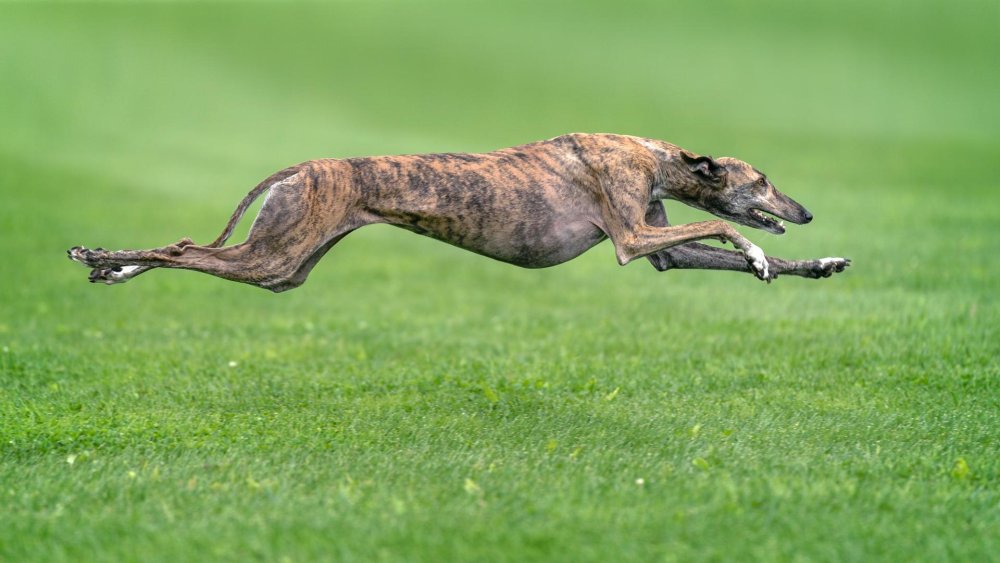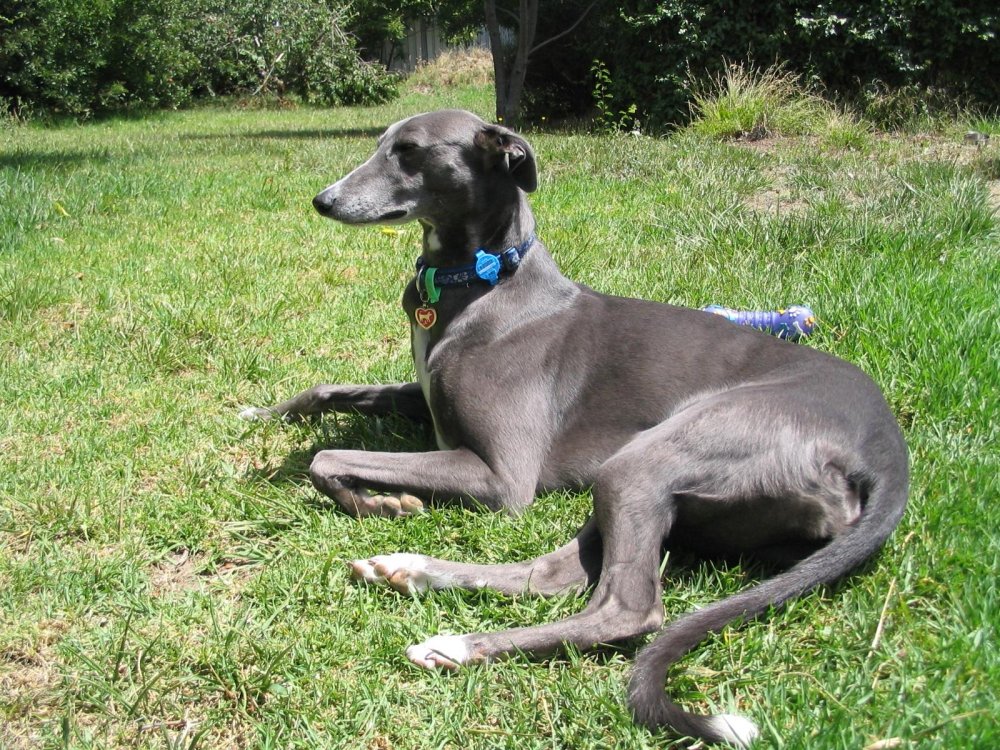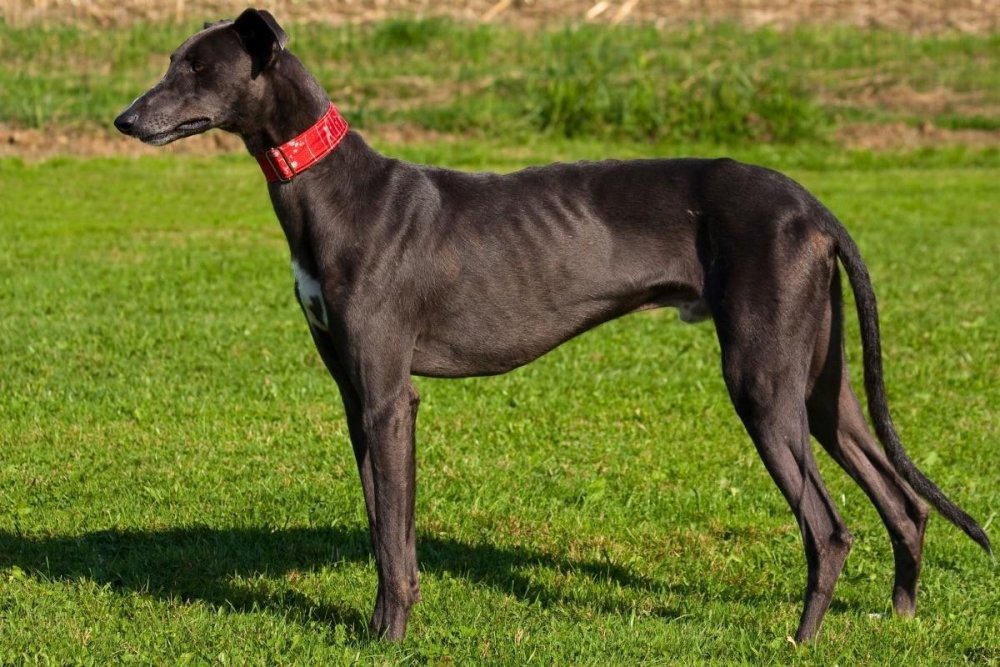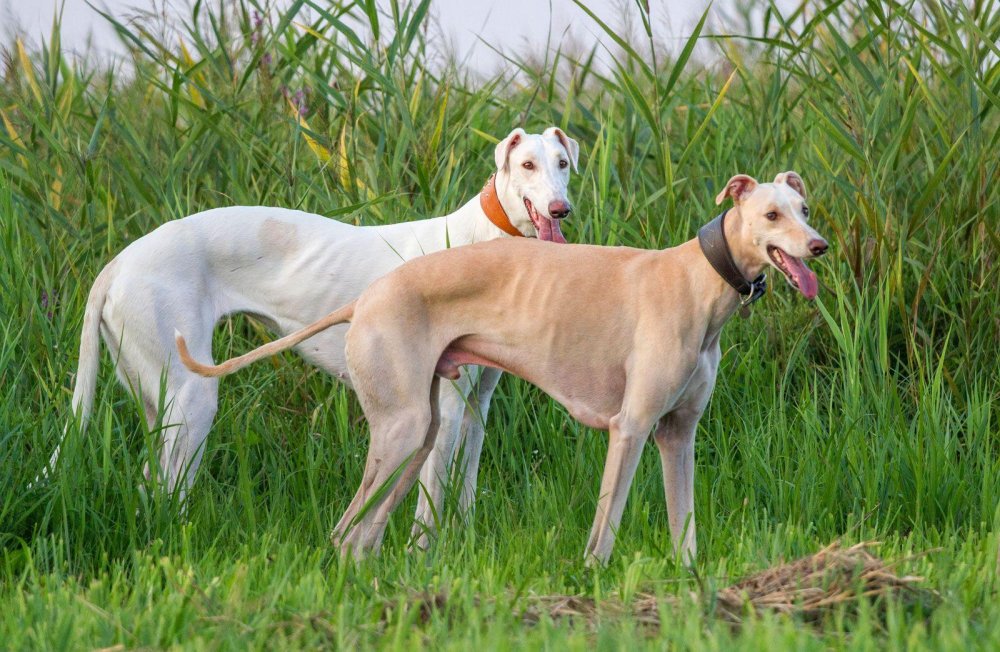- Breed Category: Hound Group
- Country of Origin: United Kingdom
- Average Height: Males 71-76 cm, Females 68-71 cm
- Average Weight: Males 29-32 kg, Females 27-29 kg
- Average Life Span: 10-14 years
- Grooming Requirements: Low, occasional brushing
- Exercise Requirements: High, needs daily exercise
- Coat Type: Short and smooth
- Coat Color Variations: Various, including black, fawn, red
- Shedding Level: Low
- Ear Type: Folded
- Tail Type: Long and tapered
- Temperament: Gentle, friendly, and calm
- Intelligence Level: High
- Barking Tendency: Low
- Compatibility with Children: Good, very gentle
- Compatibility with Other Pets: Generally good, may chase small animals
- Training Ease: Moderate, responds well to positive reinforcement
- Common Health Issues: Bloat, hip dysplasia, heart issues
- Dietary Needs: High-quality diet, monitor portions
- Energy Level: Moderate to high
- Drooling Tendency: Low
- Sensitivity to Weather: Sensitive to cold
- Overall Maintenance Level: Low
- Original Purpose: Hunting and racing
- Year of Recognition by Kennel Clubs: 1885
- Famous Breed Representatives: Santa’s Little Helper from The Simpsons
- Apartment Friendly: Yes, with sufficient exercise
- Best Suited For: Active families, singles, seniors
- Cost of Ownership: Moderate to high
- Unique Traits: Incredible speed, gentle nature
- Cultural Significance: Symbol of speed and grace
- Popularity Rank: Moderate
Imagine a cheetah in the dog world, and you’ve got the Greyhound. Known for their sleek, aerodynamic build, these dogs are the epitome of speed and grace. But there’s more to them than just their racing prowess. This article dives into the Greyhound’s unique characteristics, rich history, and the care they require.
Originating from ancient Egypt, Greyhounds have been companions to humans for thousands of years. Revered for their hunting skills, they were once the prized possessions of pharaohs and nobility. Over time, their role evolved from hunters to racers, and now, beloved pets. Understanding their past helps us appreciate their present, and this article aims to shed light on what makes Greyhounds truly special.
The Greyhound: A Breed of Speed and Elegance

Early Development of the Breed
Greyhounds have a storied past that stretches back to ancient times. Initially bred for their speed and agility, these dogs were perfect for hunting game in open fields. Their lineage can be traced to the deserts of Egypt, where they were depicted in ancient art and revered for their hunting prowess. Over centuries, selective breeding honed their speed and grace, making them the swift companions we know today.
Role in Hunting and Racing
Originally, Greyhounds were the go-to choice for hunting deer and hare, thanks to their incredible speed and keen eyesight. As time went on, their role shifted from the fields to the racetrack. Greyhound racing became a popular sport, showcasing their speed and competitive spirit. Today, while racing remains a part of their identity, many Greyhounds enjoy a more relaxed life as cherished family pets.
Key Historical Figures and Events
Throughout history, Greyhounds have been associated with nobility and royalty. Figures like Cleopatra and Queen Elizabeth I were known to have kept Greyhounds, further cementing their status as dogs of distinction. The breed’s history is also marked by the establishment of Greyhound racing in the 20th century, which brought them into the public eye and highlighted their athletic abilities.
Physical Characteristics
Greyhounds are instantly recognisable by their slender, aerodynamic bodies. They have long legs, a narrow waist, and a deep chest, all contributing to their incredible speed. Their short, smooth coat comes in a variety of colours, from black and white to brindle. Despite their athletic build, Greyhounds are surprisingly gentle and make excellent companions, known for their calm and affectionate nature.
Appearance and Unique Traits
Greyhounds are a sight to behold with their sleek, aerodynamic build. Standing tall and slender, they have long legs and a narrow waist that make them look like they’re built for speed. Their coat is short and smooth, coming in a variety of colours like black, white, fawn, and brindle. Some even have distinctive markings that add to their unique charm.
What sets Greyhounds apart is their incredible speed. They can reach up to 70 km/h, making them one of the fastest dog breeds. This speed is thanks to their powerful hindquarters and flexible spine, which allow them to cover ground quickly and efficiently. Despite their athletic prowess, they’re surprisingly gentle and laid-back.
Temperament and Behaviour
Greyhounds are known for their calm and gentle nature. They’re often described as couch potatoes, enjoying a good nap as much as a sprint. They’re affectionate and form strong bonds with their families, making them excellent companions. While they’re generally quiet, they do have a playful side and enjoy a good run in a safe, enclosed area.
Greyhound Personality and Family Suitability

Typical Personality Traits
Greyhounds are gentle, intelligent, and calm. They have a laid-back nature, often enjoying lounging around the house. Despite their racing background, they’re surprisingly low-maintenance when it comes to energy levels. Their intelligence makes them quick learners, and they’re known for their affectionate disposition.
Suitability as a Family Pet and Racing Dog
As family pets, Greyhounds are a fantastic choice. Their gentle nature makes them great companions for all ages. They adapt well to home life, enjoying the company of their human family. While they have a history in racing, many retired Greyhounds transition beautifully into family life, bringing a unique blend of athleticism and relaxation.
Interaction with Children and Other Animals
Greyhounds are generally good with children, displaying patience and gentleness. They tend to get along well with other dogs, though their prey drive means caution is needed around smaller animals. Early socialisation helps them adapt to various household dynamics.
Training and Exercise Needs
Training a Greyhound is usually straightforward due to their intelligence. Positive reinforcement works best. While they enjoy a good sprint, they don’t require excessive exercise. Regular walks and occasional runs in a secure area keep them happy and healthy.
Training, Exercise, and Health of Greyhounds
Importance of Early Training and Socialisation
Getting your Greyhound started with training and socialisation early on is crucial. These dogs are naturally gentle, but introducing them to different environments, people, and other animals helps them become well-rounded companions. Early exposure reduces anxiety and builds confidence, making them more adaptable to various situations.
Recommended Training Techniques
Greyhounds respond well to positive reinforcement. Use treats, praise, and gentle encouragement to teach them commands and good behaviour. Consistency is key, and short, engaging sessions work best. Avoid harsh methods, as these can lead to fear or anxiety.
Daily Exercise Requirements and Activities They Enjoy
Despite their racing history, Greyhounds are surprisingly low-energy. They enjoy a daily walk and the occasional sprint in a secure area. Activities like fetch or agility can be fun, but they’re just as happy lounging around the house. Balance is important to keep them fit and content.
Health and Lifespan
Greyhounds are generally healthy dogs with a lifespan of 10 to 14 years. Regular vet check-ups, a balanced diet, and proper dental care are essential. They’re prone to certain conditions like bloat and hip dysplasia, so monitoring their health is important. With the right care, they can lead long, happy lives.
Health and Care for Greyhounds

Common Health Issues
Greyhounds are generally healthy, but like any breed, they have some common health concerns. They can be prone to bloat, a serious condition that requires immediate attention. Hip dysplasia and heart issues are also seen in some Greyhounds. Regular vet visits help catch these early.
Average Lifespan and Health Tips
With proper care, Greyhounds typically live between 10 to 14 years. To keep them healthy, ensure they have a balanced diet and regular exercise. While they love a good sprint, they’re also content with daily walks. Keeping their weight in check is crucial to avoid stress on their joints.
Preventative Care Recommendations
Routine vet check-ups are essential. Vaccinations, dental care, and parasite prevention should be part of their health regimen. Regular grooming, including nail trimming and ear cleaning, helps prevent infections and keeps them comfortable.
Grooming and Maintenance
Greyhounds have a short, smooth coat that’s easy to maintain. Weekly brushing helps remove loose hair and keeps their coat shiny. They don’t have a strong odour, so baths are only needed occasionally. Regular grooming sessions also provide a great opportunity to check for any skin issues or abnormalities.
Coat Care and Grooming for Greyhounds

Coat Care and Grooming Routines
Greyhounds have a short, sleek coat that’s pretty low-maintenance. A quick brush once a week is usually enough to keep their coat looking its best. This not only helps remove loose hair but also keeps their skin healthy. They don’t have a strong doggy odour, so baths are only needed occasionally, maybe once every few months or if they get particularly dirty.
Shedding and Seasonal Grooming Tips
While Greyhounds don’t shed as much as some other breeds, they do have seasonal shedding periods. During these times, you might want to brush them a bit more often to manage the extra hair. A rubber grooming mitt can be handy for this, as it helps lift loose fur while giving them a nice massage.
Diet and Nutrition
Feeding your Greyhound a balanced diet is crucial for their health and energy levels. Look for high-quality dog food that lists meat as the first ingredient. They benefit from a diet rich in protein and healthy fats. Be mindful of their weight, as Greyhounds can be prone to joint issues if they become overweight. Fresh water should always be available, and treats should be given in moderation.
Nutritional Needs for Optimal Health

Foods to Include and Avoid
Greyhounds thrive on a diet rich in high-quality protein and healthy fats. Look for dog food where meat is the first ingredient. Fish oil or flaxseed can be beneficial for their coat and skin. Avoid foods with excessive fillers like corn and soy, as these can lead to digestive issues. Also, steer clear of artificial additives and preservatives.
Feeding Schedules and Portion Recommendations
Feeding your Greyhound twice a day is generally recommended. This helps prevent bloat, a condition they can be prone to. Portion sizes depend on their age, weight, and activity level, but typically range from 1.5 to 3 cups of dry food per meal. Always consult with your vet to tailor the diet to your dog’s specific needs.
Fun Facts and Trivia
Did you know Greyhounds have been around for over 4,000 years? They were even mentioned in the Bible! Despite their speed, they’re often called “40 mph couch potatoes” because they love lounging around. And here’s a quirky fact: Greyhounds have a unique blood type that makes them universal donors for other dogs.
Interesting Tidbits and Famous Greyhounds

Fascinating Facts About Greyhounds
Greyhounds are not just about speed; they have some pretty cool quirks too. For instance, they have a unique blood type that makes them universal donors for other dogs. This makes them invaluable in veterinary medicine. And despite their reputation as sprinters, they’re often referred to as “40 mph couch potatoes” because they love lounging around just as much as they love running.
Famous Greyhounds in Media and History
Greyhounds have made their mark in history and media. One of the most famous Greyhounds was Mick the Miller, a racing legend in the UK during the 1920s and 1930s. His success on the track made him a household name and even led to a film about his life. In the world of fiction, Greyhounds have appeared in various movies and TV shows, often depicted as elegant and noble creatures, reflecting their real-life demeanour.
Final Thoughts

Greyhounds embody elegance and speed in the canine world. Their gentle nature and unique history make them exceptional companions. While they require specific care and attention, the rewards of owning a Greyhound are immense, offering both companionship and a glimpse into a storied past. Embrace the opportunity to welcome a Greyhound into your life, and experience the joy of this remarkable breed. Whether as a family pet or a retired racer, Greyhounds continue to capture hearts and enrich lives.
